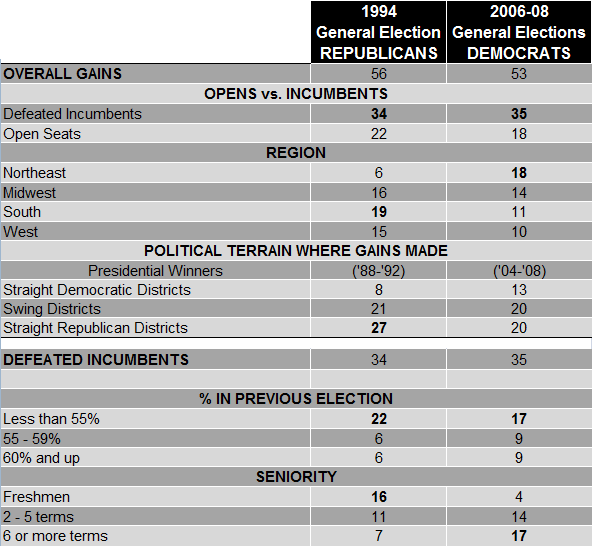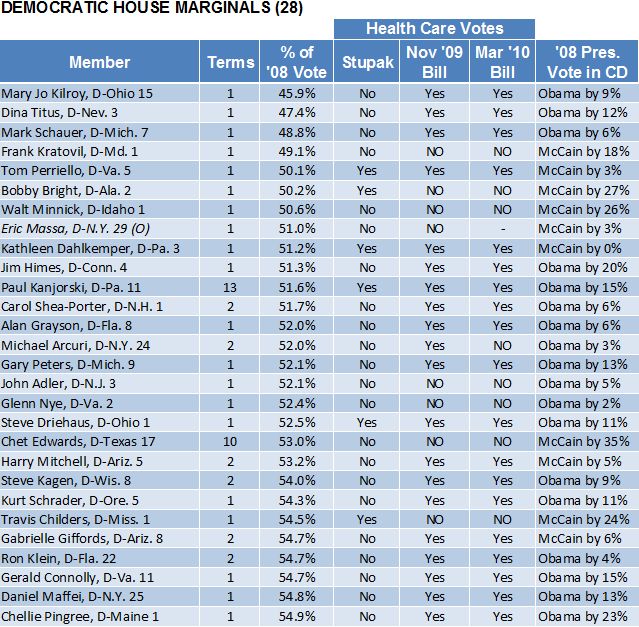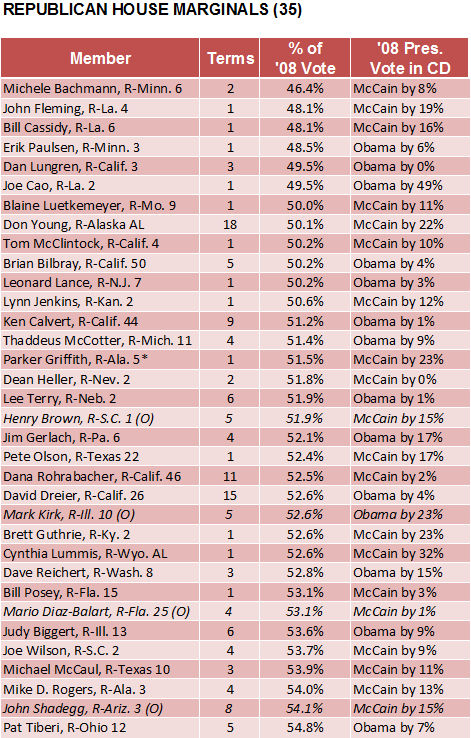Hamstrung By Health Care?
A Commentary By Rhodes Cook
Each party in the last two decades has benefited from “big wave” elections to win control of the House of Representatives – the Republicans in 1994, the Democrats in 2006 and 2008, when they turned a distinct minority in the House into a solid majority.
Whether 2010 will be another such historic election that restores the GOP to House control will depend on what happens in the next seven months – voter reaction to health care reform and other Obama administration initiatives, the state of national security and the ongoing wars in the Middle East, and most importantly, the progress made in reviving the struggling economy.
The Republicans in 1994 and the Democrats in the general elections of 2006-8 each gained more than 50 House seats, with victories that were both nationwide in scope and more dependent on ousting large numbers of the other party’s incumbents than winning open seats.
That is not often the case in quieter election years, when action is frequently focused on open seats and only a few scattered incumbents face voter rejection. But in the volatile atmosphere of “big wave” elections, incumbents can be swept away in large numbers. In 1994 and again in the pro-Democratic general elections of 2006 and 2008, roughly three dozen incumbents were defeated each time.
There are also some distinct differences between the two sets of elections in terms of the seniority of the members defeated, the amount of electoral vulnerability they projected, and the nature of the political terrain that switched party hands.
But those same dynamics that characterized 1994 and 2006-8 will probably need to play out again in 2010 for the Republicans to have as big a year as they hope for.
1994: A “Model” Election
The Republican tidal wave of 1994 could be considered a “model” election of sorts. The defeated Democratic House members were largely of a type that are viewed as vulnerable – narrow winners in their previous election, stuck in difficult political terrain, and in large measure, freshmen.
To be sure, there were several long-time Democratic heavyweights that were ousted that year – led by House Speaker Thomas Foley of Washington, a 15-term House veteran; former House Ways and Means Committee Chairman Dan Rostenkowski of Illinois, an 18-term veteran; and House Judiciary Committee Chairman Jack Brooks of Texas, who had 21 terms in Congress under his belt.
Their defeats came as a shock, but they should not have been totally unexpected. The trio was part of what is now a closely watched category called “declining incumbents.” Foley, Rostenkowski and Brooks all drew a higher share of the vote in 1990 than they did in 1992, when all three were beginning to show signs of electoral vulnerability.
There was also considerable logic to the type of districts that the Republicans picked up in 1994. They gained 27 seats in friendly terrain (districts that had voted for the GOP in the previous two presidential elections), 21 seats in swing districts that had voted Republican in 1988 but not 1992, and only eight seats in districts that had voted Democratic in both ’88 and ’92 at the presidential level.
Not surprisingly, it was difficult for the Democrats to regain many of these seats in the elections that followed, enabling the Republicans to retain a House majority for a dozen years. It was not until the economy turned sour and the antipathy to President George W. Bush in particular and the Republican brand in general hit a critical mass that Democrats could regain the upper hand.
2006-08: Against the Grain
The Democrats’ electoral route back to House control was a bit different than the Republicans’ path in 1994. The GOP House members that were defeated in 2006 and 2008 were predominantly veteran members, many with a dozen or more years in Congress. The number of Republican casualties that were House freshmen could be counted on one hand.
And unlike 1994, the recent Democratic success has not been closely tied to picking off the most politically marginal Republicans. Roughly half of the three dozen or so GOP incumbents ousted in 2006 and 2008 were coming off elections where they had won with more than 55 percent of the vote, generally the threshold dividing politically vulnerable members from those that are less so.
But what appears most pertinent for 2010 is that the vast majority of seats that the Democrats picked up in general elections the last four years were not on friendly terrain. Forty were in districts that voted for President George W. Bush in 2004, and half of those also supported Republican John McCain in 2008.
In short, the Democrats’ ability to expand into hostile terrain has helped give them a much larger House majority than the Republicans ever enjoyed after 1994. But it has left the Democrats exposed to the prospect of significant losses in an election like this one where they do not have the wind at their back.
Playing good defense is an obvious necessity for the Democrats this fall. But their ultimate success at maintaining control of the House could come down to their ability to counterattack and pick off enough seats to offset at least some of the expected Republican gains.
Neither the Democrats in 1994 nor the Republicans more recently were able to amount much of a counterattack. Their response to the “big wave” gains of the “out” party was a pick up of no more than five seats. If Democrats end up facing another such tempest in 2010, they will need to do a lot better than that.
Chart 1. The “Big Wave” Elections of 1994 and 2006-08: Sources of House Seat Shifts
The Republicans in 1994 and the Democrats in 2006 and 2008 each gained more than 50 House seats, in the process transforming themselves from a minority to the majority in Congress’ lower chamber. There were some similarities in the two sets of elections. The sweeping gains by the “out” party were both national in scope, and the defeat of dozens of incumbents was critical to the success of the Republicans in 1994 and the Democrats a decade later. But there were also some significant differences between the two sets of “big wave” elections, with the most distinct the seniority of incumbents defeated. The Republicans in 1994 picked off a number of Democratic freshmen, while the Democrats in 2006 and ‘08 were much more successful in ousting senior Republican members.
Note: This chart is based on results from the general elections of 1994, 2006 and 2008. No special election results are included, with the exception of one Democratic incumbent defeated in 1994 who had been elected in a 1993 special election. He is counted among the freshmen and sub-55% winners. The 1994 total of Republican gains is a gross figure and does not include the four seats lost by the GOP that year. The total of Democratic gains in 2006 and 2008 includes only those seats picked up by the Democrats in the two general elections and still held after 2008. It does not include special election victories or the Vermont at-large seat, which from independent to Democratic in 2006.
Sources: The 1994 general election breakdown of Republican House gains is based on a compilation of data by the author from that year’s edition of Politics in America (CQ Press). Similarly, the data on 2006 and 2008 Democratic general election gains is from America Votes 28 (CQ Press), as well as www.swingstateproject.com for the presidential vote by congressional district
Chart 2. Atop the 2010 Target List? The House Marginals and Their Health Care Votes
Any Democratic House incumbent with a close election campaign in their recent past, problematic terrain to run on, and a controversial vote or two on their record can expect a tough reelection fight in 2010. And in this volatile environment, a few Republicans in similar straits might find themselves targeted as well. Below is a list of the Democratic and Republican House members that won in 2008 with less than 55 percent of the total vote. Those retiring in 2010 – including Democratic Rep. Eric Massa of New York, who has already stepped down – are indicated in italics. Major health care votes cast in this Congress are included for the Democratic members. No House Republican voted against the anti-abortion amendment put forward by Rep. Bart Stupak (D-Mich.) or in favor of passage of the bill in November or March, with the exception of Joe Cao of Louisiana. He broke ranks to support initial House passage of the legislation in November, but lined up with other Republicans in opposing House passage of the Senate version last weekend.
Note: An asterisk (*) indicates that Parker Griffith changed his party affiliation from Democratic to Republican in December 2009.
Rhodes Cook is a senior columnist at the Center for Politics at the University of Virginia
See Other Commentary by Rhodes Cook
See Other Political Commentary
Views expressed in this column are those of the author, not those of Rasmussen Reports.
Rasmussen Reports is a media company specializing in the collection, publication and distribution of public opinion information.
We conduct public opinion polls on a variety of topics to inform our audience on events in the news and other topics of interest. To ensure editorial control and independence, we pay for the polls ourselves and generate revenue through the sale of subscriptions, sponsorships, and advertising. Nightly polling on politics, business and lifestyle topics provides the content to update the Rasmussen Reports web site many times each day. If it's in the news, it's in our polls. Additionally, the data drives a daily update newsletter and various media outlets across the country.
Some information, including the Rasmussen Reports daily Presidential Tracking Poll and commentaries are available for free to the general public. Subscriptions are available for $4.95 a month or 34.95 a year that provide subscribers with exclusive access to more than 20 stories per week on upcoming elections, consumer confidence, and issues that affect us all. For those who are really into the numbers, Platinum Members can review demographic crosstabs and a full history of our data.
To learn more about our methodology, click here.


